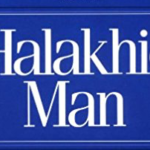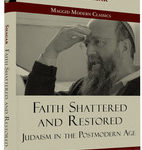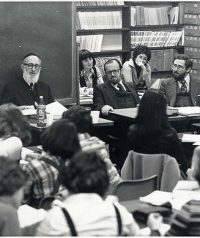In Shir ha-Shirim Rabbah, Ben Azzai is described as stringing the words of Torah together like beads, from the Torah to the Prophets, and from the Prophets to the Writings. Sitting and interpreting, with fire blazing around him, Ben Azzai tells R. Akiva, “I am sitting and stringing [like beads] the words of Torah, from Torah to the Prophets, and from Prophets to the Writings, and the words are as joyous as on the day they were given from Sinai, and as sweet as the essence of what was given…at Sinai.”[1]
By stringing together the words of different parts of Scripture, Ben Azzai causes the words to rejoice as they did when they were given as Sinai. However, Ben Azzai’s mysterious expression of “stringing words together” is left unexplained by the midrash, leaving the reader uncertain of what Ben Azzai is describing. In Intertextuality and the Reading of Midrash, Daniel Boyarin, a leading scholar of midrash and Jewish studies argues that “stringing words of Torah together” refers to the writing of midrash itself; for, according to Boyarin, midrash is the rabbinic text which interprets the Biblical text through combining and recombining the words of Scripture.
Before turning to Boyarin’s intertextual theory of midrash, a brief overview of midrash is in order. Though the definition and methodology of midrash continue to be contested by scholars today the defining feature of midrash, which distinguishes it from other halakhic and aggadic teachings, is its necessary textual connection to the Scriptural text.[2],[3] Perhaps one of the greatest challenges of understanding midrash is its characteristic of producing ideas in connection to the Biblical text which are nowhere to be found within the text itself. In the Guide of the Perplexed, Maimonides outlines three approaches toward understanding this aspect of midrash. Maimonides writes that the first approach is to accept midrash as the “correct” understanding of the text, which Hazal somehow received and imparted. The second approach is to simply dismiss midrash for its departure from the literal meaning of the text. The third approach, which Maimonides himself seems to hold, is to view midrash as [rabbinic] “poetry whose meaning is not obscure for someone endowed with understanding.”[4]
Today, perhaps in part due to the departure from logocentric theories of a “correct meaning” or text, most scholars explore midrash most closely to the third of these three approaches[5].[6] For example, David Stern, a scholar of classical and modern Jewish literature writes that midrash is a creative platform which the Rabbis innovated to “maintain the presence of Scripture [and thereby of God] in their lives.” [7] However, other scholars take issue with the notion of midrash as merely “poetry,” or the creative expression of ideas rooted in Biblical text. After all, the midrashists themselves describe midrash as “the handle” with which readers can “carry the boiling pot of water,” or Torah.[8] Because the midrash sees itself as interpretive of the Biblical text, other scholars argue that this central aspect of midrash cannot be overlooked.
Perhaps, if the midrash is characterized by its textual connection to the Biblical text, while at the same time making claims about this text that seem to be textually unrooted, it is this paradoxical connection which must be explored. In Intertextuality and the Reading of Midrash, Boyarin argues that midrash is predicated upon the “gapped” nature of the Biblical text.[9] The idea of Biblical “gaps” refers to the ambiguities and unexplained inconsistencies present within many Biblical texts.[10] While Bible critics often turn to Higher Criticism to resolve seeming gaps and inconsistencies within the text, Boyarin argues that midrash turns to Scripture itself to fill the gaps the reader encounters upon a close reading of the Biblical text. Boyarin explores the midrash’s method of filling Biblical gaps through Scripture in light of the literary theory of intertextuality.
In the 1960s, the literary critic Julia Kristeva coined the term “intertextuality”, referring to the way texts are shaped by other texts, called intertexts. Though these intertexts are often subconsciously included in texts, they are also included though forms like quotation, allusion, and translation. Kristeva wrote, “Every text builds itself as a mosaic of questions, every text is absorption and transformation of another text.”[11] In his work, Boyarin shows how midrashic texts are perhaps the most radical and self-conscious of texts in their “simultaneous uprooting and stabilizing” of the Biblical text (the intertext) they serve to interpret and expound[12]. According to Boyarin, the characteristic of midrash which makes it so openly intertextual is its unique use of biblical quotation. While the common understanding of the role of biblical quotation in midrash is to simply provide an authoritative proof text for the midrash’s ideas, Boyarin argues that the biblical verses interwoven into midrash are what facilitate the midrash’s creation of new meanings. “Meaning is released in this interaction of texts which neither text had on its own, in its own context,” explains Boyarin.[13] This principle is expressed powerfully in the Talmudic statement, “The words of Torah are poor in their own context, and rich in another context.”[14]
The unique intertextuality of midrash can be illustrated through the midrash in Shir ha-Shirim Rabbah on the words “and they went out into the Desert of Shur” (Exod. 15:22). This verse from Exodus serves as a pivotal bridge between the Israelites’ joyful celebration of their exodus from Egypt, and the sudden lack of water they encounter as they enter the desert. The Biblical passage goes from “Sing to the Lord, for very exalted is He” to, “The people complained unto Moses, saying, what shall we drink?” This sudden change leaves the reader grasping for textual clues to understand the Israelites’ sudden shift in attitude and faith.[15] The Biblical passage is gapped, and the midrash comes to interpret and fill the gap in this passage. The question, though, is how does the midrash find the missing pieces to fill these gaps? It is here that the intertextuality of midrash is most powerfully present; the midrash will fill these gapped passages by citing and incorporating other Scriptural passages. Boyarin describes midrash as “radical intertextual reading of the canon, in which potentially every part refers to and is interpretable by every other part.”[16] In this example, the midrash will fill the gap in this passage of Exodus by citing verses from Deuteronomy, Isaiah, and Jeremiah; to the midrashist, each of these books of the canon are in dialogue with one another, and though each book is distinct, they are all united through the Divinity they share. The midrash states:
And they went out into the Desert of Shur (Exod. 15:22). This is the desert of Kub. They have told that the desert of Kub that is eight hundred by eight hundred parsangs—all of it full of snakes and scorpions, as it is said, “Who has led us in the great and terrible desert—snake, venomous serpent, and scorpion” (Deut. 8:15).
And it says, “Burden of the beasts of the Dry-South, of the land of trial and tribulation, lioness and lion…ef’eh (Isa. 30:6). Ef’ah is the viper. They have told us that the viper sees the shadow of a bird flying in the air; he immediately conjoins [to it], and it falls down limb by limb.
Even so, “they did not say, ‘Where is the Lord who has brought us up from Egypt, who has led us in the land of drought and pits, land of desolation and the death-shadow?’” (Jer. 2:6). What is death-shadow? A place of shadow that death is therewith.[17]
The midrash first alludes to the tradition that this is a desert full of snakes and scorpions, tying this tradition to the description in the verse from Deuteronomy. Similarly, the midrash cites the verses from Isaiah and Jeremiah to describe the dire conditions of the desert. While the verse in Exodus tersely states “And they went out into the desert of Shur,” the midrash uses verses from Deuteronomy, Isaiah, and Jeremiah to explain that this desert contained beasts, viper, and the shadow of death. These descriptions help to explain the abandonment that the Israelites may have felt as they began journeying though the desert. Upon setting up this narrative, the midrash employs the verse from Jeremiah to explain that despite the trials they faced, the people “did not say, ‘where is the Lord…?’”
Boyarin sees the verse from Jeremiah as the pivotal point in the midrashic text because it is used in the midrash in the opposite sense of what it means in its original context. The verse appears in Jeremiah as a criticism of the people; despite the Lord’s kindness to the people, they refused to acknowledge this kindness, ignoring the presence of the Lord entirely. Instead of seeking the Lord, the people have satisfied themselves with futility. Jeremiah says to the people, “So says the Lord: What wrong did your forefathers find in me that they distanced themselves from me, and they went after futility and themselves became futile? And they did not say, “Where is the Lord, who brought us up from the land of Egypt, who led us in the desert, in a land of plains and pits, in a land of waste and darkness…” (Jer. 2:5-6). However, in the midrash, rather than criticizing the people for not seeking the Lord’s presence, the verse is used to highlight the people’s devotion to the Lord. The midrash describes the difficult conditions of the desert, and then incorporates this description into its praise of Israel. Despite the scorpions and beasts they encountered in the desert, the people did not say, “Where is the Lord who has brought us up from Egypt, who has led us in the land of drought and pits, land of desolation and the death-shadow?” Thus, the midrash uses the verse from Jeremiah to illustrate that Israel faithfully followed the Lord in the desert, without complaining that they were forsaken—a message largely different than the one Jeremiah relays in the original context.
The midrash’s seemingly subversive use of the Jeremiah verse may at first seem unjustified. Boyarin explains, “The tradition has been breached, but at the same time, this reading of the verse is consistent with Jeremiah’s own theology of the desert period.[18] It is after all, that prophet who says, “I have remembered for you the faithfulness of your youth, your going after me in the desert” (Jer. 2:2).” Moreover, this sentiment is expressed only a few verses before Jeremiah’s critique. Thus, while the specific verse in question is used by Jeremiah as a rebuke, it is used by the midrash as an expression of Israel’s faithfulness. Boyarin states, “The local (“original”) meaning of the verse is disrupted, but the meaning-system to which it belongs, the ideology as a whole, is vivified and confirmed.”[19] The midrash’s creative use of this verse, placed within the context of the verses from Deuteronomy and Isaiah, fills the gap within the Exodus passage. The gap is filled through the creation of inner-dialogue between different verses of Scripture itself.
However, the midrash does more than simply filling in the gap within the Exodus passage. The midrash’s dire description of the desert explains the cause for the people’s loss of faith in the Lord. However, by connecting this description to a verse about the people’s faith in the Lord despite the death-shadow desert, the midrash highlights another voice present within the Exodus passage. The people do indeed rebel against the Lord in the desert, but at the same time, as described by the prophet Jeremiah, “As a bride [they] loved [the Lord], following [the Lord] through the desert, through a land not sown” (Jer. 2:2). While explaining the possible motivation for the people’s sense of abandonment, the midrash also calls the reader’s attention to the people’s faith in the Lord; this faith is missing from the specific Exodus passage, yet is present within the whole of Scripture itself. Through interweaving verses of Scripture and placing them in dialogue with one another, the midrash fills a textual gap, while also highlighting the dialogical nature of the biblical text itself.[20]
We may never know what Ben Azzai meant when he described “stringing like beads the words of Torah, from the Torah the Prophets, and from the Prophets to the Writings.” However, the intertextuality of midrash, in which the Torah, Prophets, and Writings are interwoven to release new meanings within Scripture, seems to describe a similar process. And the reader who listens carefully may just hear the words rejoicing and blazing, as they did at Sinai.
_____________________
[1] Shir ha-Shirim Rabbah 1:10.
[2] Simi Peters, Introduction in Learning to Read Midrash (Jerusalem: Urim Publications, 2004).
[3] Simi Peters, Learning to Read Midrash,11. This necessary connection to the Biblical text applies to both midrash aggada and midrash halakha.
[4] Maimonides, Guide for the Perplexed 3:43. I thank Professor Richard Hidary for directing me to this source.
[5] In fact, the poststructuralist literary movement led to a renewed interest in the polysemic nature of midrash, where the text is never limited to only one meaning. This connection is more deeply explored by the literature and Jewish studies scholar, Susan Handelman in The Slayers of Moses. Susan Handelman, The Slayers of Moses (Albany: State University of New York Press, 1982).
[6] For example, see Geoffrey H. Hartman and Sanford Budick (eds.), Midrash and Literature, (New Haven, Conn.: Yale University Press, 1986).
[7] David Stern, Midrash and Theory: Ancient Jewish Studies and Contemporary Literary Studies (Illnois; Northwestern University Press, 1998), 38.
[8] Shir ha-Shirim Rabbah 2:31.
[9] Daniel Boyarin, Intertextuality and the Reading of Midrash (Bloomington: Indiana University Press, 1994), 20, 41.
[10] This concept is explored by 20th century literary critic, Eric Aurebach. Aurebach famously described Biblical narrative as “fraught with background,” meaning that the text often leaves out “background” information, leaving unexplained “gaps” within the narrative. Eric Aurebach, transl. by Willard R. Trask Mimesis: The Representation of Reality in Western Literature (Princeton, N.J.: Princeton University Press, 2003), 12.
[11] Johanne Prud’homme and Lyne Légaré, “A Semiology of Paragrams,” Signo: Theoretical Semiotics on the Web, available at: www.signosemio.com
[12] Boyarin, 23-24.
[13] Boyarin, 31.
[14] Jerusalem Talmud Rosh ha-Shana 3:5 [58d].
[15] These “gaps” are not spelled out by Boyarin; rather, these are the questions that seemed to emerge from this biblical passage when I read it.
[16] Daniel Boyarin,16.
[17] Lauterbach II, 87-88.
[18] Boyarin, 26.
[19] Ibid.
[20] The midrash’s approach of filling textual gaps by interweaving verses of Scripture together is perhaps a model for Kabalistic and Chassidic Biblical interpretation, where a similar process is employed.






Midrash and Intertextuality: Stringing like Beads the Words of Torah
In Shir ha-Shirim Rabbah, Ben Azzai is described as stringing the words of Torah together like beads, from the Torah to the Prophets, and from the Prophets to the Writings. Sitting and interpreting, with fire blazing around him, Ben Azzai tells R. Akiva, “I am sitting and stringing [like beads] the words of Torah, from Torah to the Prophets, and from Prophets to the Writings, and the words are as joyous as on the day they were given from Sinai, and as sweet as the essence of what was given…at Sinai.”[1]
By stringing together the words of different parts of Scripture, Ben Azzai causes the words to rejoice as they did when they were given as Sinai. However, Ben Azzai’s mysterious expression of “stringing words together” is left unexplained by the midrash, leaving the reader uncertain of what Ben Azzai is describing. In Intertextuality and the Reading of Midrash, Daniel Boyarin, a leading scholar of midrash and Jewish studies argues that “stringing words of Torah together” refers to the writing of midrash itself; for, according to Boyarin, midrash is the rabbinic text which interprets the Biblical text through combining and recombining the words of Scripture.
Before turning to Boyarin’s intertextual theory of midrash, a brief overview of midrash is in order. Though the definition and methodology of midrash continue to be contested by scholars today the defining feature of midrash, which distinguishes it from other halakhic and aggadic teachings, is its necessary textual connection to the Scriptural text.[2],[3] Perhaps one of the greatest challenges of understanding midrash is its characteristic of producing ideas in connection to the Biblical text which are nowhere to be found within the text itself. In the Guide of the Perplexed, Maimonides outlines three approaches toward understanding this aspect of midrash. Maimonides writes that the first approach is to accept midrash as the “correct” understanding of the text, which Hazal somehow received and imparted. The second approach is to simply dismiss midrash for its departure from the literal meaning of the text. The third approach, which Maimonides himself seems to hold, is to view midrash as [rabbinic] “poetry whose meaning is not obscure for someone endowed with understanding.”[4]
Today, perhaps in part due to the departure from logocentric theories of a “correct meaning” or text, most scholars explore midrash most closely to the third of these three approaches[5].[6] For example, David Stern, a scholar of classical and modern Jewish literature writes that midrash is a creative platform which the Rabbis innovated to “maintain the presence of Scripture [and thereby of God] in their lives.” [7] However, other scholars take issue with the notion of midrash as merely “poetry,” or the creative expression of ideas rooted in Biblical text. After all, the midrashists themselves describe midrash as “the handle” with which readers can “carry the boiling pot of water,” or Torah.[8] Because the midrash sees itself as interpretive of the Biblical text, other scholars argue that this central aspect of midrash cannot be overlooked.
Perhaps, if the midrash is characterized by its textual connection to the Biblical text, while at the same time making claims about this text that seem to be textually unrooted, it is this paradoxical connection which must be explored. In Intertextuality and the Reading of Midrash, Boyarin argues that midrash is predicated upon the “gapped” nature of the Biblical text.[9] The idea of Biblical “gaps” refers to the ambiguities and unexplained inconsistencies present within many Biblical texts.[10] While Bible critics often turn to Higher Criticism to resolve seeming gaps and inconsistencies within the text, Boyarin argues that midrash turns to Scripture itself to fill the gaps the reader encounters upon a close reading of the Biblical text. Boyarin explores the midrash’s method of filling Biblical gaps through Scripture in light of the literary theory of intertextuality.
In the 1960s, the literary critic Julia Kristeva coined the term “intertextuality”, referring to the way texts are shaped by other texts, called intertexts. Though these intertexts are often subconsciously included in texts, they are also included though forms like quotation, allusion, and translation. Kristeva wrote, “Every text builds itself as a mosaic of questions, every text is absorption and transformation of another text.”[11] In his work, Boyarin shows how midrashic texts are perhaps the most radical and self-conscious of texts in their “simultaneous uprooting and stabilizing” of the Biblical text (the intertext) they serve to interpret and expound[12]. According to Boyarin, the characteristic of midrash which makes it so openly intertextual is its unique use of biblical quotation. While the common understanding of the role of biblical quotation in midrash is to simply provide an authoritative proof text for the midrash’s ideas, Boyarin argues that the biblical verses interwoven into midrash are what facilitate the midrash’s creation of new meanings. “Meaning is released in this interaction of texts which neither text had on its own, in its own context,” explains Boyarin.[13] This principle is expressed powerfully in the Talmudic statement, “The words of Torah are poor in their own context, and rich in another context.”[14]
The unique intertextuality of midrash can be illustrated through the midrash in Shir ha-Shirim Rabbah on the words “and they went out into the Desert of Shur” (Exod. 15:22). This verse from Exodus serves as a pivotal bridge between the Israelites’ joyful celebration of their exodus from Egypt, and the sudden lack of water they encounter as they enter the desert. The Biblical passage goes from “Sing to the Lord, for very exalted is He” to, “The people complained unto Moses, saying, what shall we drink?” This sudden change leaves the reader grasping for textual clues to understand the Israelites’ sudden shift in attitude and faith.[15] The Biblical passage is gapped, and the midrash comes to interpret and fill the gap in this passage. The question, though, is how does the midrash find the missing pieces to fill these gaps? It is here that the intertextuality of midrash is most powerfully present; the midrash will fill these gapped passages by citing and incorporating other Scriptural passages. Boyarin describes midrash as “radical intertextual reading of the canon, in which potentially every part refers to and is interpretable by every other part.”[16] In this example, the midrash will fill the gap in this passage of Exodus by citing verses from Deuteronomy, Isaiah, and Jeremiah; to the midrashist, each of these books of the canon are in dialogue with one another, and though each book is distinct, they are all united through the Divinity they share. The midrash states:
And they went out into the Desert of Shur (Exod. 15:22). This is the desert of Kub. They have told that the desert of Kub that is eight hundred by eight hundred parsangs—all of it full of snakes and scorpions, as it is said, “Who has led us in the great and terrible desert—snake, venomous serpent, and scorpion” (Deut. 8:15).
And it says, “Burden of the beasts of the Dry-South, of the land of trial and tribulation, lioness and lion…ef’eh (Isa. 30:6). Ef’ah is the viper. They have told us that the viper sees the shadow of a bird flying in the air; he immediately conjoins [to it], and it falls down limb by limb.
Even so, “they did not say, ‘Where is the Lord who has brought us up from Egypt, who has led us in the land of drought and pits, land of desolation and the death-shadow?’” (Jer. 2:6). What is death-shadow? A place of shadow that death is therewith.[17]
The midrash first alludes to the tradition that this is a desert full of snakes and scorpions, tying this tradition to the description in the verse from Deuteronomy. Similarly, the midrash cites the verses from Isaiah and Jeremiah to describe the dire conditions of the desert. While the verse in Exodus tersely states “And they went out into the desert of Shur,” the midrash uses verses from Deuteronomy, Isaiah, and Jeremiah to explain that this desert contained beasts, viper, and the shadow of death. These descriptions help to explain the abandonment that the Israelites may have felt as they began journeying though the desert. Upon setting up this narrative, the midrash employs the verse from Jeremiah to explain that despite the trials they faced, the people “did not say, ‘where is the Lord…?’”
Boyarin sees the verse from Jeremiah as the pivotal point in the midrashic text because it is used in the midrash in the opposite sense of what it means in its original context. The verse appears in Jeremiah as a criticism of the people; despite the Lord’s kindness to the people, they refused to acknowledge this kindness, ignoring the presence of the Lord entirely. Instead of seeking the Lord, the people have satisfied themselves with futility. Jeremiah says to the people, “So says the Lord: What wrong did your forefathers find in me that they distanced themselves from me, and they went after futility and themselves became futile? And they did not say, “Where is the Lord, who brought us up from the land of Egypt, who led us in the desert, in a land of plains and pits, in a land of waste and darkness…” (Jer. 2:5-6). However, in the midrash, rather than criticizing the people for not seeking the Lord’s presence, the verse is used to highlight the people’s devotion to the Lord. The midrash describes the difficult conditions of the desert, and then incorporates this description into its praise of Israel. Despite the scorpions and beasts they encountered in the desert, the people did not say, “Where is the Lord who has brought us up from Egypt, who has led us in the land of drought and pits, land of desolation and the death-shadow?” Thus, the midrash uses the verse from Jeremiah to illustrate that Israel faithfully followed the Lord in the desert, without complaining that they were forsaken—a message largely different than the one Jeremiah relays in the original context.
The midrash’s seemingly subversive use of the Jeremiah verse may at first seem unjustified. Boyarin explains, “The tradition has been breached, but at the same time, this reading of the verse is consistent with Jeremiah’s own theology of the desert period.[18] It is after all, that prophet who says, “I have remembered for you the faithfulness of your youth, your going after me in the desert” (Jer. 2:2).” Moreover, this sentiment is expressed only a few verses before Jeremiah’s critique. Thus, while the specific verse in question is used by Jeremiah as a rebuke, it is used by the midrash as an expression of Israel’s faithfulness. Boyarin states, “The local (“original”) meaning of the verse is disrupted, but the meaning-system to which it belongs, the ideology as a whole, is vivified and confirmed.”[19] The midrash’s creative use of this verse, placed within the context of the verses from Deuteronomy and Isaiah, fills the gap within the Exodus passage. The gap is filled through the creation of inner-dialogue between different verses of Scripture itself.
However, the midrash does more than simply filling in the gap within the Exodus passage. The midrash’s dire description of the desert explains the cause for the people’s loss of faith in the Lord. However, by connecting this description to a verse about the people’s faith in the Lord despite the death-shadow desert, the midrash highlights another voice present within the Exodus passage. The people do indeed rebel against the Lord in the desert, but at the same time, as described by the prophet Jeremiah, “As a bride [they] loved [the Lord], following [the Lord] through the desert, through a land not sown” (Jer. 2:2). While explaining the possible motivation for the people’s sense of abandonment, the midrash also calls the reader’s attention to the people’s faith in the Lord; this faith is missing from the specific Exodus passage, yet is present within the whole of Scripture itself. Through interweaving verses of Scripture and placing them in dialogue with one another, the midrash fills a textual gap, while also highlighting the dialogical nature of the biblical text itself.[20]
We may never know what Ben Azzai meant when he described “stringing like beads the words of Torah, from the Torah the Prophets, and from the Prophets to the Writings.” However, the intertextuality of midrash, in which the Torah, Prophets, and Writings are interwoven to release new meanings within Scripture, seems to describe a similar process. And the reader who listens carefully may just hear the words rejoicing and blazing, as they did at Sinai.
_____________________
[1] Shir ha-Shirim Rabbah 1:10.
[2] Simi Peters, Introduction in Learning to Read Midrash (Jerusalem: Urim Publications, 2004).
[3] Simi Peters, Learning to Read Midrash,11. This necessary connection to the Biblical text applies to both midrash aggada and midrash halakha.
[4] Maimonides, Guide for the Perplexed 3:43. I thank Professor Richard Hidary for directing me to this source.
[5] In fact, the poststructuralist literary movement led to a renewed interest in the polysemic nature of midrash, where the text is never limited to only one meaning. This connection is more deeply explored by the literature and Jewish studies scholar, Susan Handelman in The Slayers of Moses. Susan Handelman, The Slayers of Moses (Albany: State University of New York Press, 1982).
[6] For example, see Geoffrey H. Hartman and Sanford Budick (eds.), Midrash and Literature, (New Haven, Conn.: Yale University Press, 1986).
[7] David Stern, Midrash and Theory: Ancient Jewish Studies and Contemporary Literary Studies (Illnois; Northwestern University Press, 1998), 38.
[8] Shir ha-Shirim Rabbah 2:31.
[9] Daniel Boyarin, Intertextuality and the Reading of Midrash (Bloomington: Indiana University Press, 1994), 20, 41.
[10] This concept is explored by 20th century literary critic, Eric Aurebach. Aurebach famously described Biblical narrative as “fraught with background,” meaning that the text often leaves out “background” information, leaving unexplained “gaps” within the narrative. Eric Aurebach, transl. by Willard R. Trask Mimesis: The Representation of Reality in Western Literature (Princeton, N.J.: Princeton University Press, 2003), 12.
[11] Johanne Prud’homme and Lyne Légaré, “A Semiology of Paragrams,” Signo: Theoretical Semiotics on the Web, available at: www.signosemio.com
[12] Boyarin, 23-24.
[13] Boyarin, 31.
[14] Jerusalem Talmud Rosh ha-Shana 3:5 [58d].
[15] These “gaps” are not spelled out by Boyarin; rather, these are the questions that seemed to emerge from this biblical passage when I read it.
[16] Daniel Boyarin,16.
[17] Lauterbach II, 87-88.
[18] Boyarin, 26.
[19] Ibid.
[20] The midrash’s approach of filling textual gaps by interweaving verses of Scripture together is perhaps a model for Kabalistic and Chassidic Biblical interpretation, where a similar process is employed.